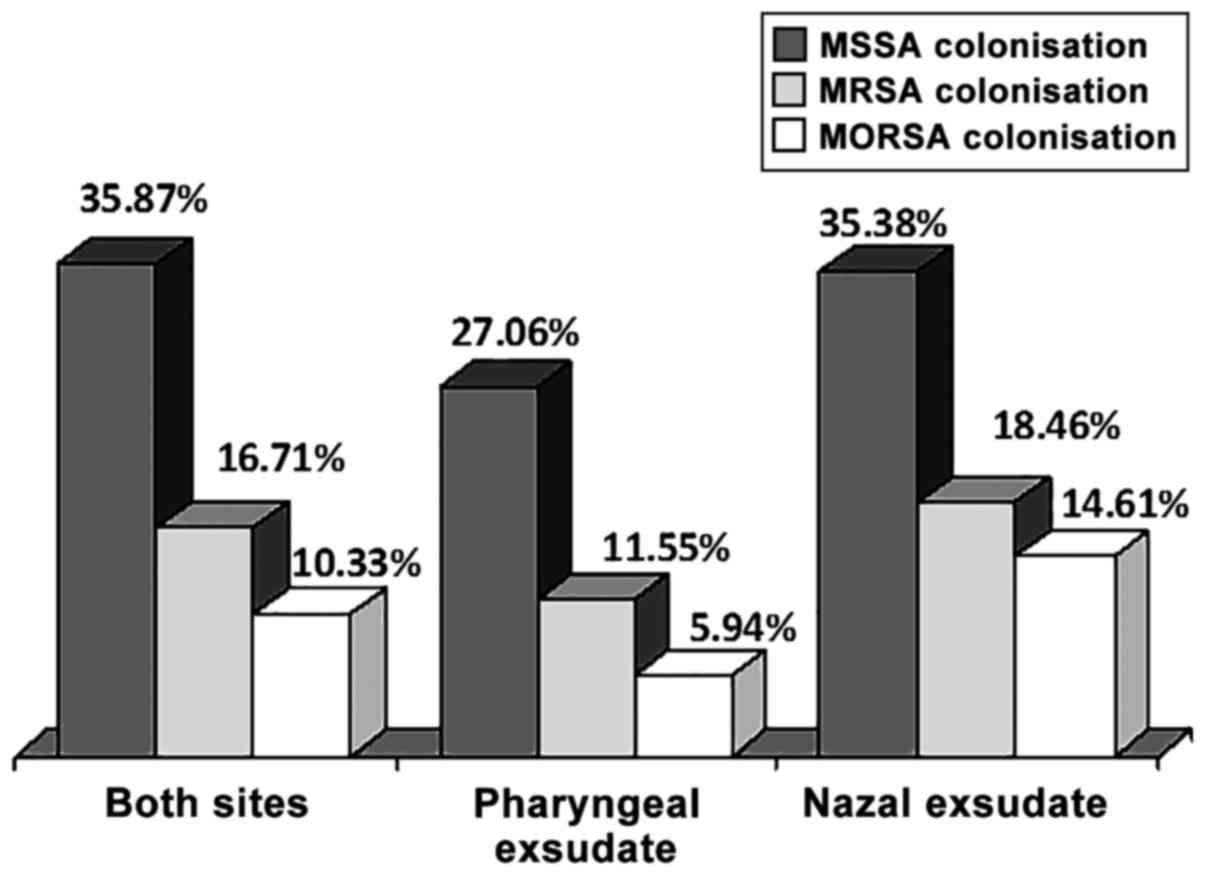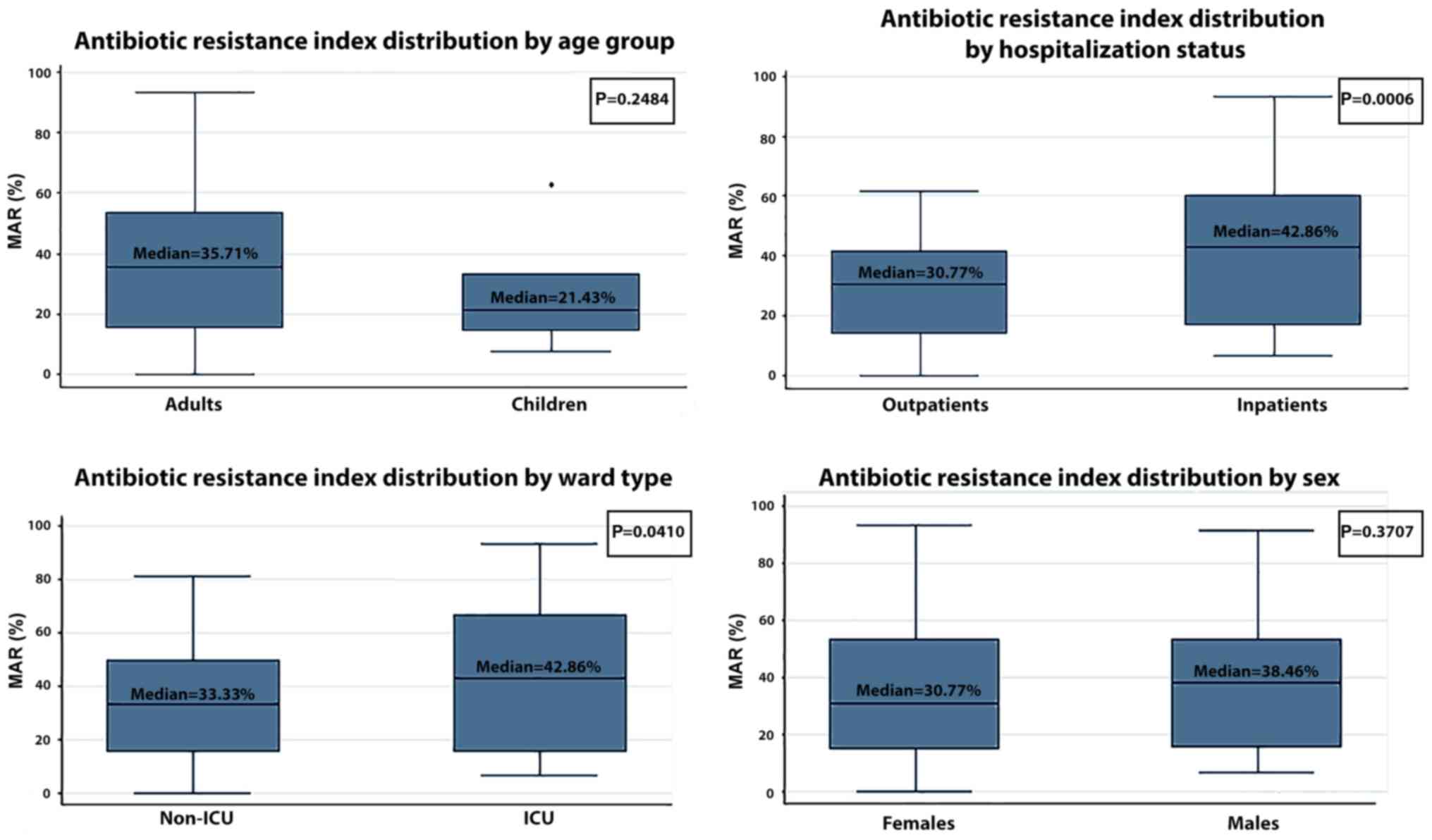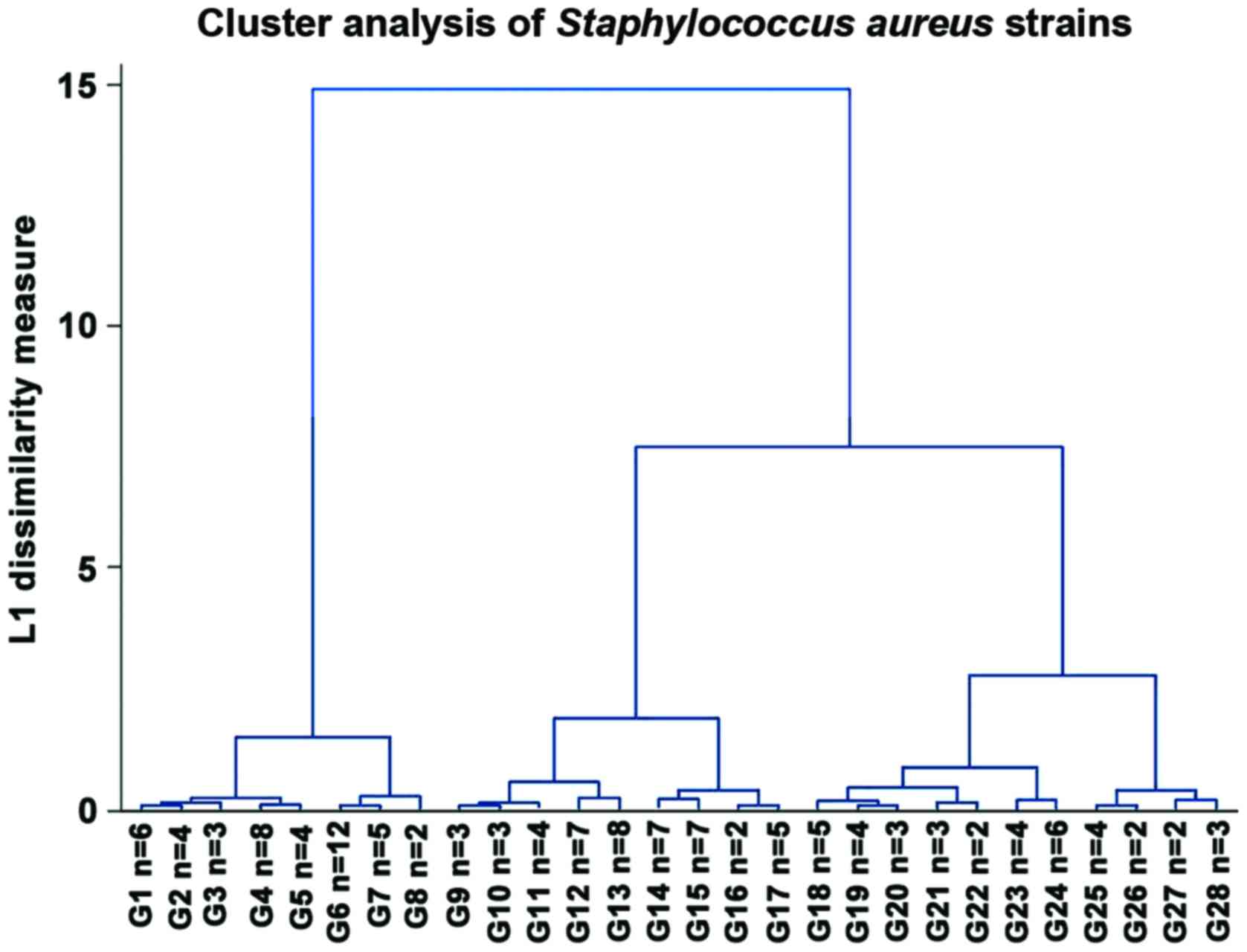|
1
|
Tong SY, Chen LF and Fowler VG Jr:
Colonization, pathogenicity, host susceptibility, and therapeutics
for Staphylococcus aureus: What is the clinical relevance? Semin
Immunopathol. 34:185–200. 2012. View Article : Google Scholar : PubMed/NCBI
|
|
2
|
Hidron AI, Kourbatova EV, Halvosa JS,
Terrell BJ, McDougal LK, Tenover FC, Blumberg HM and King MD: Risk
factors for colonization with methicillin-resistant Staphylococcus
aureus (MRSA) in patients admitted to an urban hospital: Emergence
of community-associated MRSA nasal carriage. Clin Infect Dis.
41:159–166. 2005. View
Article : Google Scholar : PubMed/NCBI
|
|
3
|
Călina D, Docea AO, Roşu L, Zlatian O,
Roşu AF, Anghelina F, Rogoveanu O, Arsene AL, Nicolae AC, Drăgoi
CM, et al: Antimicrobial resistance development following surgical
site infections. Mol Med Rep. 15:681–688. 2017. View Article : Google Scholar : PubMed/NCBI
|
|
4
|
Tănase A, Coliță A, Ianoşi G, Neagoe D,
Brănişteanu DE, Călina D, Docea AO, Tsatsakis A and Ianoşi SL: Rare
case of disseminated fusariosis in a young patient with graft vs.
host disease following an allogeneic transplant. Exp Ther Med.
12:2078–2082. 2016. View Article : Google Scholar : PubMed/NCBI
|
|
5
|
Wojciechowski VV, Călina D, Tsarouhas K,
Pivnik AV, Sergievich AA, Kodintsev VV, Filatova EA, Ozcagli E,
Docea AO, Arsene AL, et al: A guide to acquired vitamin K
coagulophathy diagnosis and treatment: The Russian perspective.
Daru. 25:102017. View Article : Google Scholar : PubMed/NCBI
|
|
6
|
Călina D, Roșu L, Roșu AF, Ianoşi G,
Ianoşi S, Zlatian O, Mitruț R, Docea AO, Rogoveanu O, Mitruț P, et
al: Etiological diagnosis and pharmacotherapeutic management of
parapneumonic pleurisy. Farmacia. 64:946–952. 2016.
|
|
7
|
Joung DK, Mun SH, Choi SH, Kang OH, Kim
SB, Lee YS, Zhou T, Kong R, Choi JG, Shin DW, et al: Antibacterial
activity of oxyresveratrol against methicillin-resistant
Staphylococcus aureus and its mechanism. Exp Ther Med.
12:1579–1584. 2016. View Article : Google Scholar : PubMed/NCBI
|
|
8
|
Zhang H, Li H, Liu Y, Li Q, Bi Y and Fang
G: Upregulated effects of miR-7 in methicillin-resistant
Staphylococcus aureus. Exp Ther Med. 12:3571–3574. 2016. View Article : Google Scholar : PubMed/NCBI
|
|
9
|
Fernandes FH, Guterres ZR, Violante IMP,
Lopes TFS, Garcez WS and Garcez FR: Evaluation of mutagenic and
antimicrobial properties of brown propolis essential oil from the
Brazilian Cerrado biome. Toxicol Rep. 2:1482–1488. 2015. View Article : Google Scholar : PubMed/NCBI
|
|
10
|
Khan IH, Sohran H, Rony SR, Tareq FS,
Hasan CM and Mazid A: Cytotoxic and antibacterial naphthoquinones
from an endophytic fungus, Cladosporium sp. Toxicol Rep. 3:861–865.
2016. View Article : Google Scholar : PubMed/NCBI
|
|
11
|
Koneman EW, Allen SD, Janda WM,
Schreckenberger RC and Winn W: Introduction to microbiology. Part
II: Guidelines for collection, transport, processing, analysis, and
reporting of cultures from specific specimen sourcesColor Atlas and
Textbook of Diagnostic Microbiology. 5th edition. Lippincott,
Philadelphia: pp. 121–170. 1997
|
|
12
|
Clinical and Laboratory Standards
Institute (CLSI), . Performance standards for antimicrobial
susceptibility testing16th informational supplement M100-S16. CLSI;
Wayne, PA: 2015
|
|
13
|
Ianoşi S, Ianoşi G, Neagoe D, Ionescu O,
Zlatian O, Docea AO, Badiu C, Sifaki M, Tsoukalas D, Tsatsakis AM,
et al: Age-dependent endocrine disorders involved in the
pathogenesis of refractory acne in women. Mol Med Rep.
14:5501–5506. 2016. View Article : Google Scholar : PubMed/NCBI
|
|
14
|
Cioboată R, Găman A, Traşcă D, Ungureanu
A, Docea AO, Tomescu P, Gherghina F, Arsene AL, Badiu C, Tsatsakis
AM, et al: Pharmacological management of non-alcoholic fatty liver
disease: Atorvastatin versus pentoxifylline. Exp Ther Med.
13:2375–2381. 2017. View Article : Google Scholar : PubMed/NCBI
|
|
15
|
Davis KA, Stewart JJ, Crouch HK, Florez CE
and Hospenthal DR: Methicillin-resistant Staphylococcus aureus
(MRSA) nares colonization at hospital admission and its effect on
subsequent MRSA infection. Clin Infect Dis. 39:776–782. 2004.
View Article : Google Scholar : PubMed/NCBI
|
|
16
|
Finks J, Wells E, Dyke TL, Husain N,
Plizga L, Heddurshetti R, Wilkins M, Rudrik J, Hageman J, Patel J
and Miller C: Vancomycin-resistant Staphylococcus aureus, Michigan,
USA, 2007. Emerg Infect Dis. 15:943–945. 2009. View Article : Google Scholar : PubMed/NCBI
|
|
17
|
Perl TM, Cullen JJ, Wenzel RP, Zimmerman
MB, Pfaller MA, Sheppard D, Twombley J, French PP and Herwaldt LA;
Mupirocin And The Risk Of Staphylococcus aureus Study Team, :
Intranasal mupirocin to prevent postoperative Staphylococcus aureus
infections. N Engl J Med. 346:1871–1877. 2002. View Article : Google Scholar : PubMed/NCBI
|
|
18
|
Muder RR, Brennen C, Wagener MM, Vickers
RM, Rihs JD, Hancock GA, Yee YC, Miller JM and Yu VL:
Methicillin-resistant staphylococcal colonization and infection in
a long-term care facility. Ann Intern Med. 114:107–112. 1991.
View Article : Google Scholar : PubMed/NCBI
|
|
19
|
Cristea OM, Zlatian OM, Dinescu SN,
Bălăşoiu T, Avrămescu C, Bălăşoiu M, Niculescu M and Călina D: A
comparative study on antibiotic resistance of Klebsiella strains
from surgical and intensive care wards. Curr Health Sci.
42:169–179. 2016.
|
|
20
|
Eslami G, Salehifar E, Behbudi M and Rezai
MS: Rational use of amikacin in Buali-Sina hospital in Sari 2011. J
Mazandaran Univ Med Sci. 23:2–9. 2013.
|
|
21
|
Cantón R, Novais A, Valverde A, Machado E,
Peixe L, Baquero F and Coque TM: Prevalence and spread of
extended-spectrum beta-lactamase-producing Enterobacteriaceae in
Europe. Clin Microbiol Infect. 14 Suppl 1:144–153. 2008. View Article : Google Scholar : PubMed/NCBI
|
|
22
|
Rujanavej V, Soudry E, Banaei N, Baron EJ,
Hwang PH and Nayak JV: Trends in incidence and susceptibility among
methicillin-resistant Staphylococcus aureus isolated from
intranasal cultures associated with rhinosinusitis. Am J Rhinol
Allergy. 27:134–137. 2013. View Article : Google Scholar : PubMed/NCBI
|
|
23
|
Dellit TH, Owens RC, McGowan JE Jr,
Gerding DN, Weinstein RA, Burke JP, Huskins WC, Paterson DL,
Fishman NO, Carpenter CF, et al Infectious Diseases Society of
America, ; Society for Healthcare Epidemiology of America, :
Infectious Diseases Society of America and the Society for
Healthcare Epidemiology of America guidelines for developing an
institutional program to enhance antimicrobial stewardship. Clin
Infect Dis. 44:159–177. 2007. View
Article : Google Scholar : PubMed/NCBI
|
|
24
|
Bratzler DWI, Dellinger EP, Olsen KM, Perl
TM, Auwaerter PG, Bolon MK, Fish DN, Napolitano LM, Sawyer RG,
Slain D, et al American Society of Health-System Pharmacists, ;
Infectious Disease Society of America, ; Surgical Infection
Society, ; Society for Healthcare Epidemiology of America, :
Clinical practice guidelines for antimicrobial prophylaxis in
surgery. Am J Health Syst Pharm. 70:195–283. 2013. View Article : Google Scholar : PubMed/NCBI
|
|
25
|
Pantosti A and Venditti M: What is MRSA?
Eur Respir J. 34:1190–1196. 2009. View Article : Google Scholar : PubMed/NCBI
|
|
26
|
Reddy PN, Srirama K and Dirisala VR: An
update on clinical burden, diagnostic tools, and therapeutic
options of Staphylococcus aureus. Infect Dis (Auckl).
10:11799161177039992017.PubMed/NCBI
|
|
27
|
de Sousa M Aires and de Lencastre H:
Evolution of sporadic isolates of methicillin-resistant
Staphylococcus aureus (MRSA) in hospitals and their similarities to
isolates of community-acquired MRSA. J Clin Microbiol.
41:3806–3815. 2003. View Article : Google Scholar : PubMed/NCBI
|
|
28
|
Otto M: MRSA virulence and spread. Cell
Microbiol. 14:1513–1521. 2012. View Article : Google Scholar : PubMed/NCBI
|
|
29
|
Zhou T, Li Z, Kang OH, Mun SH, Seo YS,
Kong R, Shin DW, Liu XQ and Kwon DY: Antimicrobial activity and
synergism of ursolic acid 3-O-α-L-arabinopyranoside with oxacillin
against methicillin-resistant Staphylococcus aureus. Int J Mol Med.
40:1285–1293. 2017.PubMed/NCBI
|
|
30
|
Arora S, Devi P, Arora U and Devi B:
Prevalence of methicillin-resistant Staphylococcus aureus (MRSA) in
a tertiary care Hospital in Northern India. J Lab Physician.
2:78–81. 2010. View Article : Google Scholar
|
|
31
|
Shrestha B, Pokhrel BM and Mohapatra TM:
Phenotypic characterization of nosocomial isolates of
Staphylococcus aureus with reference to MRSA. J Infect Dev Ctries.
3:554–560. 2009. View
Article : Google Scholar : PubMed/NCBI
|













